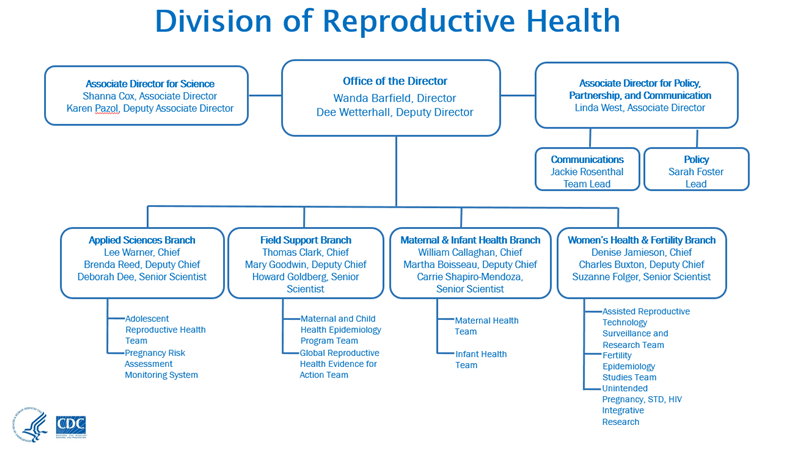Organizational Chart
CDC's Division of Reproductive Health organizational components include the Office of the Director and four branches. A diverse workforce of approximately 170 people including medical officers, epidemiologists, statisticians, programmers, public health educators, secretaries, behavioral scientists, nurses, research psychologists, program analysts, health communications specialists, and public health advisors support a wide range of programs and projects.

View or Print DRH Organization Chart Adobe PDF file [PDF - 66KB]
Office of the Director
CDC’s Division of Reproductive Health (DRH), Office of the Director
- Determines program priorities.
- Plans activities including the organization of human and financial resources.
- Establishes standards for quality control of research, surveillance, and program implementation.
- Monitors progress toward achieving program objectives.
- Assesses the impact of the DRH’s activities on improved pregnancy outcomes and improved reproductive health.
- Reports accomplishments, future directions, and resource requirements.
- Coordinates and leads reproductive health activities across CDC and with other agencies in the public and private sectors.
Associate Director for Science
This office provides scientific vision and leadership to promote quality and integrity of CDC science, and helps to encourage the application of science to solve important public health problems.
Associate Director for Policy, Partnership and Communication
- Coordinates the policy, partnership, and communication activities.
- Establishes and interprets policies and determines priorities to communicate the value and benefits of DRH programs.
- Promotes priorities through analysis of policies and programs.
- Develops DRH-wide planning, evaluation, and budget documents.
- Conducts health communications and media services to promote DRH activities and resources.
- Works with partners to translate science into public health practice.
Applied Sciences Branch
This branch promotes optimal and equitable reproductive health through the translation of science to practice in collaboration with national, state, tribal, territory, and community partners; develops and implements evidence-based initiatives; and monitors health behaviors and outcomes through surveillance, epidemiology, and research.
Adolescent Reproductive Health Team
Promotes sexual and reproductive health among adolescents and young adults with a primary focus on young people facing disparities and highest rates of unintended pregnancy. Through partnerships and capacity building, the team accomplishes its mission by translating science into practice to reduce sexual risk behaviors and promote healthy youth development.
Pregnancy Risk Assessment Monitoring System (PRAMS) Team
Through a cooperative agreement with 40 states and New York City, PRAMS collects state-specific, population-based data on maternal experiences before, during, and after pregnancy—representing about 78% of all live births in the United States. PRAMS provides data not available from other sources and allows comparisons among participating states. These data are routinely used by CDC and state public health agencies to monitor changes in maternal and child health indicators, monitor access to and receipt of services, and inform the planning for state maternal and infant health programs and policies.
Field Support Branch
This branch enhances scientific and technical capacity nationally and globally to strengthen and apply the evidence base for public health action to improve the health and well-being of women, children, and families.
Maternal and Child Health Epidemiology Team
Promotes and improves the health and well-being of women, children, and families by building capacity at state, local, and tribal levels and by using and applying sound epidemiologic research and scientific information to maternal and child health programs and policies.
Global Reproductive Health Evidence for Action Team
Improves maternal and infant health around the globe by strengthening the evidence base and public health capacity through our technical leadership and innovation, and actively engaging in and promoting quality data collection, analysis, interpretation, and dissemination to inform strategies and interventions.
Maternal and Infant Health Branch
Improve scientific leadership in the promotion of women’s health before, during, and after pregnancy, and to reduce maternal and infant mortality, with special attention to reducing disparities in these health outcomes.
Infant Health Team
Investigates the causes of death and short- and long-term consequences of morbidity during the first year of life, placing special emphasis on preterm birth, sudden unexpected infant deaths and racial or ethnic disparities through research, surveillance, and quality improvement.
Maternal Health Team
Provides scientific leadership in the promotion of maternal health and in the reduction of pregnancy-related complications and maternal deaths, with special attention to reducing disparities in these health outcomes.
Women's Health and Fertility Branch
This branch conducts epidemiologic surveillance, research, and field investigations on issues involving women’s health, unintended pregnancy prevention, prevention of HIV in women, fertility and infertility, and contraceptive safety and effectiveness.
Assisted Reproductive Technology Surveillance and Research Team
Promotes the health of women and men who receive infertility services, the health of pregnancies achieved through these services, and the health of infants conceived through these services. This is achieved by conducting surveillance and research, creating and maintaining strategic partnerships, and moving science to practice.
Fertility Epidemiology Studies Team
Conducts primary research and secondary analysis of data to inform the field of contraception and related reproductive issues throughout the lifespan.
Unintended Pregnancy, STD, HIV Integrative Research Team
Conducts epidemiologic, clinical and behavioral research integrating the study of prevention (HIV, STIs, and unintended pregnancy) with promotion of health among women of reproductive age, their partners, and their children. This team conducts research that is interdisciplinary, multi-focused, and related to both domestic and international programs.
- Page last reviewed: June 16, 2016
- Page last updated: June 16, 2016
- Content source:


 ShareCompartir
ShareCompartir